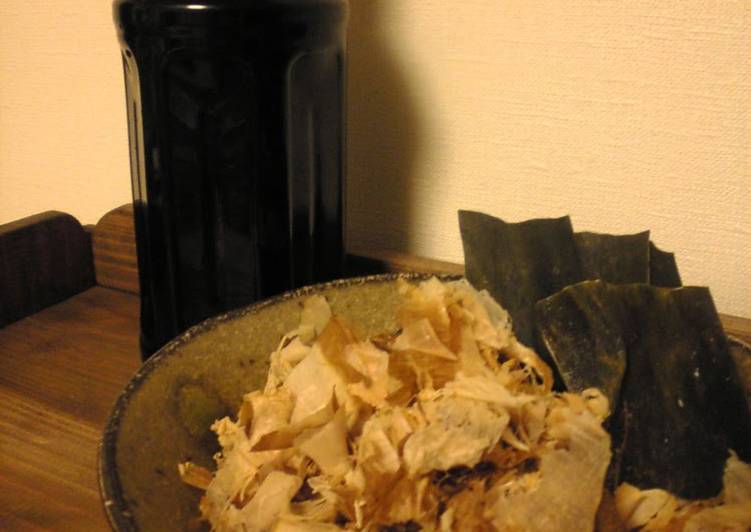All-Purpose Traditional Japanese Sauce (Dashi Soy Sauce). Japanese soy sauce, or shoyu, is an essential part of Japanese cuisine. Without this sauce, many of your favorite Japanese dishes would not exist. But did you know soy sauce comes in different flavors, colors, and textures?
Family heat as well as distance can be acquired in easy ways. Among them is by food preparation, and serving food for the household.
With food preparation can likewise make your family satisfied, you require a scrumptious recipe.
If you like cooking, then you require a broad collection of recipes. Because your family needs to be burnt out if the dishes are not differed. On this web site there are lots of the most effective dishes. In this write-up we'll cover several of the most tasty All-Purpose Traditional Japanese Sauce (Dashi Soy Sauce) recays.
Below is a All-Purpose Traditional Japanese Sauce (Dashi Soy Sauce) recipe that you can mimic to serve your cherished family.
 Making ichiban dashi using kombu and fish flakes(bonito flakes).
Bonito is a tuna like fish.
Like miso, soy sauce is a fermented and aged product.
You can have All-Purpose Traditional Japanese Sauce (Dashi Soy Sauce) using 6 active ingredients as well as 4 actions. Here is just how we prepare.
Making ichiban dashi using kombu and fish flakes(bonito flakes).
Bonito is a tuna like fish.
Like miso, soy sauce is a fermented and aged product.
You can have All-Purpose Traditional Japanese Sauce (Dashi Soy Sauce) using 6 active ingredients as well as 4 actions. Here is just how we prepare.
Components of All-Purpose Traditional Japanese Sauce (Dashi Soy Sauce)
- Detaile. 300 ml of Soy sauce.
- Directions. 300 ml of Sake.
- Step by step. 200 ml of Mirin.
- Detaile. 20 grams of Bonito flakes (about 2 big handfuls).
- Detaile. 10 grams of Kombu for dashi stock (about 4 to 5 10 cm x 3 cm pieces).
- Guidelines. 1 of Shredded nori seaweed, white sesame seeds (for the furikake).
The kanji characters for soy sauce or shoyu are 醤油, which literally means 'fermented food oil' - so in Japanese and Chinese there's no 'soy' at all in the 'soy sauce' name. Even using soy sauce - one of the signature seasonings of Japan, still leaves making authentic Japanese food a challenge. We would like to introduce a seasoning called Dashi Soy Sauce - a blend of dashi and soy sauce. Let's explore Dashi and see how adding it to traditional soy sauce.
This Is To Make All-Purpose Traditional Japanese Sauce (Dashi Soy Sauce)
- Put all the ingredients except the nori seaweed and sesame seeds into a pan and turn on the heat. Once it comes to a boil, turn the heat down to low and simmer. Continue simmering for 15 to 20 minutes until the liquid has reduced by 2/3..
- Take the pan off the heat, and let cool. When it's cooled, strain it through a fine meshed sieve or paper towels. You'll end up with about 500 ml of dashi..
- How to reuse leftover bonito flakes: Spread it out on parchment paper-lined baking sheet. Bake in an oven preheated to 195-210°F/90-100°C. Around the time you've forgotten about it, it will be nicely dried (about 1 hour). P.S. Be careful not heat the oven too high, this will dry out the flakes. You can also dry-roast in a frying pan..
- Add finely shredded nori seaweed and white sesame seeds, for gorgeous, delicious bonito flake furikake! Store in an airtight container in the refrigerator. I recommend eating this with rice! It's so good!.
All the dried ingredients that are used to make Japanese soup stock are rich in naturally occurring glutamates and provide intense flavor to the stock. Use when you want a nice savory stock to go with other strong distinct flavors or seasoning like soy sauce, but don't use it. All types of dashi impart a rich, savory taste, thanks to the naturally occurring glutamic acid in the dried ingredients the dashi stock requires. Japanese dashi is best used on the day it's made. If you have some leftover dashi, however, keep it in a covered container refrigerated for up to a week or freeze to.
That's the dish for All-Purpose Traditional Japanese Sauce (Dashi Soy Sauce), do not fail to remember to practice it promptly in the house so that your family members will be happy.